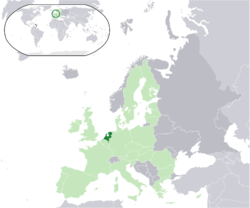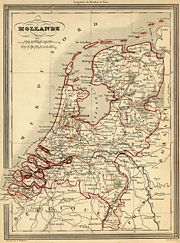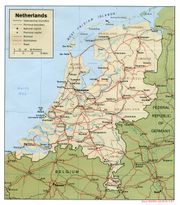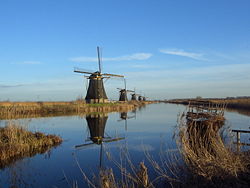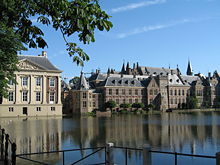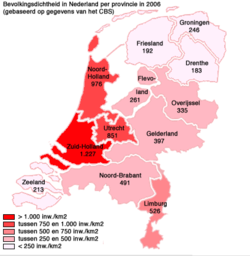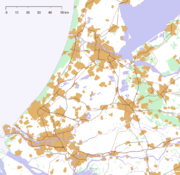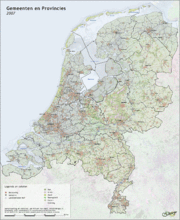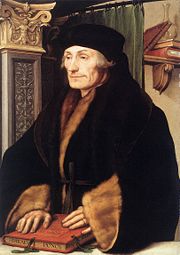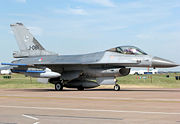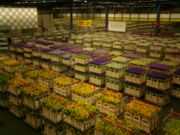Netherlands
2008/9 Schools Wikipedia Selection. Related subjects: Europe; European Countries
|
||||||||||||||||||||||||||||||||||||||||||||||||||||||||||||||||||||||||||||||||||||||||||||||||||||||||||||||||||||||||||||
The Netherlands (Dutch: Nederland , IPA: [ˈne:dərlɑnt]) is the European part of the Kingdom of the Netherlands, which consists of the Netherlands, the Netherlands Antilles and Aruba in the Caribbean. The Netherlands is a parliamentary democratic constitutional monarchy, located in Western Europe. It is bordered by the North Sea to the north and west, Belgium to the south, and Germany to the east.
The Netherlands is often called Holland. This is formally incorrect as North and South Holland in the western Netherlands are only two of the country's twelve provinces. Still, many Dutch people colloquially refer to their country as Holland in this way, as a synecdoche. For more on this and other naming issues see terminology of the Netherlands.
The Netherlands is a geographically low-lying and densely populated country. It is popularly known for its traditional windmills, tulips, cheese, clogs (wooden shoes), delftware and gouda pottery, for its bicycles, its dikes and surge barriers, and, on the other hand, traditional values and civil virtues such as its classic social tolerance. An old parliamentary democracy, the country is more recently known for its rather liberal policies toward recreational drugs, prostitution, homosexuality, and euthanasia.
The Netherlands has an international outlook; among other affiliations the country is a founding member of the European Union (EU), NATO, the OECD, and has signed the Kyoto protocol. Along with Belgium and Luxembourg, the Netherlands is one of three member nations of the Benelux economic union. The country is host to five international (ised) courts: the Permanent Court of Arbitration, the International Court of Justice, the International Criminal Tribunal for the Former Yugoslavia, the International Criminal Court and the Special Tribunal for Lebanon. All of these courts (except the Special Tribunal for Lebanon), as well as the EU's criminal intelligence agency ( Europol), are situated in The Hague, which has led to the city being referred to as "the world's legal capital."
A remarkable aspect of the Netherlands is its flatness. Hilly landscapes can be found only in the south-eastern tip of the country on the foothills of the Ardennes, the central part and where the glaciers pushed up several hilly ridges such as the Hondsrug in Drenthe, the stuwwallen (push moraines) near Arnhem and Nijmegen, Salland, Twente and the Utrechtse Heuvelrug.
History
Under Charles V, Holy Roman Emperor, and king of Spain, the region was part of the Seventeen Provinces of the Netherlands, which also included most of present-day Belgium, Luxembourg, and some land of France and Germany. 1568 saw the start of the Eighty Years' War between the provinces and Spain. In 1579, the northern half of the Seventeen Provinces formed the Union of Utrecht, a treaty in which they promised to support each other in their defense against the Spanish army. The Union of Utrecht is seen as the foundation of the modern Netherlands. In 1581 the northern provinces adopted the Act of Abjuration, the declaration of independence in which the provinces officially deposed Philip II. Philip II the son of Charles V, was not prepared to let them go easily and war continued until 1648 when Spain under King Philip IV finally recognised Dutch independence in the Treaty of Münster.
Dutch Republic 1581-1795
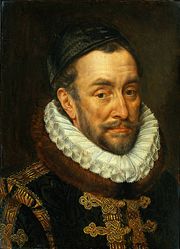
Since their independence from Phillip II in 1581 the provinces formed the Republic of the Seven United Netherlands. The republic was a confederation of the provinces Holland, Zeeland, Groningen, Friesland, Utrecht, Overijssel and Gelre. All these provinces were autonomous and had their own government, the "States of the Province". The States-General, the confederal government, were seated in The Hague and consisted of representatives from each of the seven provinces. The very thinly populated region of Drenthe, mainly consisting of poor peatland, was part of the Republic too, although Drenthe was not considered one of the provinces. Drenthe had its own States but the landdrost of Drenthe was appointed by the States-General.
The Republic occupied a number of so-called Generality Lands (Generaliteitslanden in Dutch). These territories were governed directly by the States-General, so they did not have a government of their own and they did not have representatives in the States-General. Most of these territories were occupied during the Eighty Years' War. They were mainly Roman Catholic and they were used as a buffer zone between the Republic and the Southern Netherlands.
The Dutch grew to become one of the major seafaring and economic powers of the 17th century during the period of the Republic of the Seven United Netherlands. In the so-called Dutch Golden Age, colonies and trading posts were established all over the globe. (See Dutch colonial empire)
Many economic historians regard the Netherlands as the first thoroughly capitalist country in the world. In early modern Europe it featured the wealthiest trading city (Amsterdam) and the first full-time stock exchange. The inventiveness of the traders led to insurance and retirement funds as well as such less benign phenomena as the boom-bust cycle, the world's first asset-inflation bubble, the tulip mania of 1636–1637, and according to Murray Sayle, the world's first bear raider - Isaac le Maire, who forced prices down by dumping stock and then buying it back at a discount. The republic went into a state of general decline in the later 18th century, with economic competition from England and long standing rivalries between the two main factions in Dutch society, the Staatsgezinden (Republicans) and the Prinsgezinden (Royalists or Orangists) as main factors.
Under French influence 1795-1815
On 19 January 1795, a day after stadtholder William V of Orange fled to England, the Batavian Republic (Bataafse Republiek in Dutch) was proclaimed. The proclamation of the Batavian Republic introduced the concept of the unitary state in the Netherlands. From 1795 to 1806, the Batavian Republic designated the Netherlands as a republic modelled after the French Republic.
The Kingdom of Holland 1806 – 1810 (Dutch: Koninkrijk Holland, French: Royaume de Hollande) was set up by Napoleon Bonaparte as a puppet kingdom for his third brother, Louis Napoleon Bonaparte, in order to control the Netherlands more effectively. The name of the leading province, Holland, was now taken for the whole country. The kingdom of Holland covered the area of present day Netherlands, with the exception of Limburg, and parts of Zeeland, which were French territory. In 1807 Prussian East Frisia and Jever were added to the kingdom. In 1809 however, after an English invasion, Holland had to give over all territories south of the river Rhine to France.
King Louis Napoleon did not meet Napoleon's expectations — he tried to serve Dutch interests instead of his brother's — and the King had to abdicate on 1 July 1810. He was succeeded by his five year old son Napoleon Louis Bonaparte. Napoleon Louis reigned as Louis II for just ten days as Emperor Napoleon Bonaparte ignored his young nephew’s accession to the throne. The Emperor sent in an army to invade the country and dissolved the Kingdom of Holland. The Netherlands then became part of the French Empire.
From 1810 to 1813, when Napoleon Bonaparte was defeated in the battle of Leipzig, the Netherlands were part of the French Empire.
Kingdom of the Netherlands
In 1795 the last stadtholder William V of Orange fled to England. His son returned to the Netherlands in 1813 to become William I of the Netherlands, Sovereign Prince of the Netherlands. On 16 March 1815 the Sovereign Prince became King of the Netherlands.
In 1815 the Congress of Vienna formed the United Kingdom of the Netherlands, by expanding the Netherlands with Belgium in order to create a strong country on the northern border of France. In addition, William became hereditary Grand Duke of Luxembourg. The Congress of Vienna gave Luxembourg to William personally in exchange for his German possessions, Nassau-Dillenburg, Siegen, Hadamar and Diez.
Belgium rebelled and gained independence in 1830, while the personal union between Luxembourg and the Netherlands was severed in 1890, when King William III of the Netherlands died with no surviving male heirs. Ascendancy laws prevented his daughter Queen Wilhelmina from becoming the next Grand Duchess. Therefore the throne of Luxembourg passed over from the House of Orange-Nassau to the House of Nassau-Weilburg, another branch of the House of Nassau.
Colonies
The largest Dutch settlement abroad was the Cape Colony. It was established by Jan van Riebeeck on behalf of the Dutch East India Company at Cape Town (Dutch: Kaapstad) in 1652. The Prince of Orange acquiesced to British occupation and control of the Cape Colony in 1788. The Netherlands also possessed several other colonies, but Dutch settlement in these lands was limited. Most notable were the vast Dutch East Indies (now Indonesia) and Suriname (the latter was traded with the British for New Amsterdam, now known as New York). These 'colonies' were first administered by the Dutch East India Company and the Dutch West India Company, both collective private enterprises. Three centuries later these companies got into financial trouble and the territories in which they operated were taken over by the Dutch government (in 1815 and 1791 respectively). Only then did they become official colonies.
Industrialisation
During the 19th century, the Netherlands was slow to industrialize compared to neighbouring countries, mainly due to the great complexity involved in the modernizing of the infrastructure consisting largely of waterways and the great reliance its industry had on windpower.
World War I
Many historians do not recognise the Dutch involvement during World War I. However, recently historians started to change their opinion on the role of the Dutch. Although the Netherlands remained neutral during the war, it was heavily involved in the war. Von Schlieffen had originally planned to invade the Netherlands while advancing into France in the original Schlieffen Plan. This was changed by Helmuth von Moltke the Younger in order to maintain Dutch neutrality. Later during the war Dutch neutrality would prove essential to German survival up till the blockade integrated by the USA and Great Britain in 1916 when the import of goods through the Netherlands was no longer possible. However, the Dutch were able to remain neutral during the war using their diplomacy and their ability to trade.
World War II
The Netherlands remained neutral in World War I and intended to do so in World War II. However, Nazi Germany invaded the Netherlands in 1940 in the Western European campaign of the Second World War. The country was quickly overrun and the army main force surrendered on May 14 after the bombing of Rotterdam, although a Dutch and French allied force held the province of Zeeland for a short time after the Dutch surrender. The Kingdom as such continued the war from the colonial empire; the government in exile resided in London.
During the occupation over 100,000 Dutch Jews were rounded up to be transported to Nazi concentration camps in Germany, Poland and Czechoslovakia. By the time these camps were liberated, only 876 Dutch Jews survived. Dutch workers were conscripted for forced labour in German factories, civilians were killed in reprisal for attacks on German soldiers, and the countryside was plundered for food for German soldiers in the Netherlands and for shipment to Germany. Although there are many stories of Dutch people risking their lives by hiding Jews from the Germans, like in the diary of Anne Frank, there were also Dutch people who collaborated with Nazi occupiers in hunting down and arresting hiding Jews, and some joined the Waffen-SS to form the 4th SS Volunteer Panzergrenadier Brigade Netherlands, fighting on the Eastern Front.
The government-in-exile lost control of its major colonial stronghold, the Netherlands East Indies (Indonesia), to Japanese forces in March 1942. " American-British-Dutch-Australian" (ABDA) forces fought hard in some instances, but were overwhelmed. During the occupation, the Japanese interned Dutch civilians and used both them and Indonesian civilians as forced labour, both in the Netherlands East Indies and in neighbouring countries. This included forcing women to work as " comfort women" (sex slaves) for Japanese personnel. Some military personnel escaped to Australia and other Allied countries from where they carried on the fight against Japan.
After a first liberation attempt by the Allied 21st Army Group stalled, much of the northern Netherlands was subject to the Dutch famine of 1944, caused by the disrupted transportation system, caused by German destruction of dikes to slow allied advances, and German confiscation of much food and livestock and above that all a very severe winter made the "Hunger Winter" of 1944-1945 one in which malnutrition and starvation were rife among the Dutch population. German forces held out until the surrender of May 5, 1945, in Wageningen at Hotel De Wereld.
After the war
After the war, the Dutch economy prospered by leaving behind an era of neutrality and gaining closer ties with neighbouring states. The Netherlands became a member of the Benelux (Belgium, the Netherlands and Luxembourg) grouping. Furthermore, the Netherlands was among the twelve founding members of the North Atlantic Treaty Organisation (NATO) and among the six founding members of the European Coal and Steel Community, which would later evolve, via the EEC ( Common Market), into the European Union.
Geography
Floods
In years past, the Dutch coastline has changed considerably as a result of human intervention and natural disasters. Most notable in terms of land loss is the 1134 storm, which created the archipelago of Zeeland in the south west. The St. Elizabeth flood of 1421 and the mismanagement in its aftermath destroyed a newly reclaimed polder, replacing it with the 72 square kilometres (28 sq mi) Biesbosch tidal floodplains in the south-centre. The most recent parts of Zeeland were flooded during the North Sea Flood of 1953 when 1,836 people were killed, after which the Delta Plan was executed.
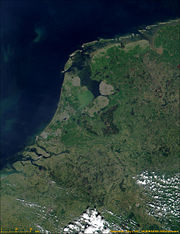
The disasters were partially increased in severity through human influence. People had drained relatively high lying swampland to use it as farmland. This drainage caused the fertile peat to compress and the ground level to drop, locking the land users in a vicious circle whereby they would lower the water level to compensate for the drop in ground level, causing the underlying peat to compress even more. The problem remains unsolvable to this day. Also, up until the 19th century peat was mined, dried, and used for fuel, further adding to the problem.
To guard against floods, a series of defences against the water were contrived. In the first millennium AD, villages and farmhouses were built on man-made hills called terps. Later, these terps were connected by dykes. In the 12th century, local government agencies called "waterschappen" (English "water bodies") or "hoogheemraadschappen" ("high home councils") started to appear, whose job it was to maintain the water level and to protect a region from floods. (These agencies exist to this day, performing the same function.) As the ground level dropped, the dykes by necessity grew and merged into an integrated system. By the 13th century, windmills had come into use in order to pump water out of areas below sea level. The windmills were later used to drain lakes, creating the famous polders. In 1932, the Afsluitdijk (English "Closure Dyke") was completed, blocking the former Zuiderzee (Southern Sea) from the North Sea and thus creating the IJsselmeer ( IJssel Lake). It became part of the larger Zuiderzee Works in which four polders totalling 2,500 km2 (965 mi2) were reclaimed from the sea.
Delta works
After the 1953 disaster, the Delta project, a vast construction effort designed to end the threat from the sea once and for all, was launched in 1958 and largely completed in 2002. The official goal of the Delta project was to reduce the risk of flooding in the province of Zeeland to once per 10,000 years. (For the rest of the country, the protection-level is once per 4,000 years.) This was achieved by raising 3,000 kilometres (1,864 miles) of outer sea-dykes and 10,000 kilometres (6,200 miles) of inner, canal, and river dikes to "delta" height, and by closing off the sea estuaries of the Zeeland province. New risk assessments occasionally show problems requiring additional Delta project dyke reinforcements. The Delta project is one of the largest construction efforts in human history and is considered by the American Society of Civil Engineers as one of the seven wonders of the modern world.
Additionally, the Netherlands is one of the countries that may suffer most from climatic change. Not only is the rising sea a problem, but also erratic weather patterns may cause the rivers to overflow.
Rivers
The country is divided into two main parts by three large rivers, the Rhine (Rijn) and its main distributary Waal, as well as the Meuse (Maas). These rivers function as a natural barrier between earlier fiefdoms, and hence created traditionally a cultural divide, as is evident in some phonetic traits that are recognisable north and south of these "Large Rivers" (de Grote Rivieren). In addition to this, there was, until quite recently, a clear religious dominance of Catholics in the south and of Protestants in the north.
The south-western part of the Netherlands is actually a massive river delta of these rivers and two tributaries of the Scheldt (Westerschelde and Oosterschelde). Only one significant branch of the Rhine flows northeastwards, the IJssel river, discharging into the IJsselmeer, the former Zuiderzee ('southern sea'). This river also happens to form a linguistic divide. People to the east of this river speak Low Saxon dialects (except for the province of Friesland that has its own language).
Climate
The predominant wind direction in the Netherlands is south-west, which causes a moderate maritime climate, with cool summers and mild winters.
Mean measurements by the KNMI weather station in De Bilt between 1971 and 2000:
| Month | Jan | Feb | Mar | Apr | May | Jun | Jul | Aug | Sep | Oct | Nov | Dec | Year |
|---|---|---|---|---|---|---|---|---|---|---|---|---|---|
| Avg. highest temp. (°C) | 5.2 | 6.1 | 9.6 | 12.9 | 17.6 | 19.8 | 22.1 | 22.3 | 18.7 | 14.2 | 9.1 | 6.4 | 13.7 |
| Avg. lowest temp. (°C) | 0.0 | -0.1 | 2.0 | 3.5 | 7.5 | 10.2 | 12.5 | 12.0 | 9.6 | 6.5 | 3.2 | 1.3 | 5.7 |
| Avg. temp. (°C) | 2.8 | 3.0 | 5.8 | 8.3 | 12.7 | 15.2 | 17.4 | 17.2 | 14.2 | 10.3 | 6.2 | 4.0 | 9.8 |
| Month | Jan | Feb | Mar | Apr | May | Jun | Jul | Aug | Sep | Oct | Nov | Dec | Year |
|---|---|---|---|---|---|---|---|---|---|---|---|---|---|
| Avg. precipitation (mm) | 67 | 48 | 65 | 45 | 62 | 72 | 70 | 58 | 72 | 77 | 81 | 77 | 793 |
| Avg. hours sunshine | 52 | 79 | 114 | 158 | 204 | 187 | 196 | 192 | 133 | 106 | 60 | 44 | 1524 |
Nature
The Netherlands has 20 national parks and hundreds of other nature reserves. Most are owned by Staatsbosbeheer and Natuurmonumenten and include lakes, heathland, woods, dunes and other habitats.
Phytogeographically, the Netherlands are shared between the Atlantic European and Central European provinces of the Circumboreal Region within the Boreal Kingdom. According to the WWF, the territory of the Netherlands belongs to the ecoregion of Atlantic mixed forests. In 1871 the last old original natural woods (Beekbergerwoud) were cut down and most woods today are planted monocultures of trees like Scots Pine and trees that are not native to the Netherlands. These woods were planted on anthropogenic heaths and sand-drifts (overgrazed heaths) ( Veluwe).
Government and administration
Government
The Netherlands has been a constitutional monarchy since 1815 and a parliamentary democracy since 1848; before that it had been a republic from 1581 to 1806, a kingdom between 1806 and 1810, and a part of France between 1810 and 1813. The Netherlands is described as a consociational state. Dutch politics and governance are characterised by an effort to achieve broad consensus on important issues, within both the political community and society as a whole. In 2007, The Economist ranked The Netherlands as the third most democratic country in the world.
The head of state is the monarch, at present Queen Beatrix. Constitutionally the monarch still has considerable powers, but in practice it has become a ceremonial function. The monarch can exert most influence during the formation of a new cabinet, where he/she serves as neutral arbiter between the political parties.
In practice the executive power is formed by de ministerraad ( Dutch cabinet). Because of the multi-party system no single party has ever held a majority in parliament since the 19th century, therefore coalition cabinets have to be formed. The cabinet consists usually of around thirteen to sixteen ministers of which between one and three ministers without portfolio, and a varying number of state secretaries. The head of government is the Prime Minister of the Netherlands, who is often, but not always, the leader of the largest party in the coalition. In practice the Prime Minister has been the leader of the largest coalition party since 1973. He is a primus inter pares, meaning he has no explicit powers that go beyond those of the other ministers.
The cabinet is responsible to the bicameral parliament, the States-General which also has legislative powers. The 150 members of the Second Chamber, the Lower House, are elected in direct elections, which are held every four years or after the fall of the cabinet (by example: when one of the chambers carries a motion of no-confidence, the cabinet offers her resignation to the monarch). The provincial assemblies are directly elected every four years as well. The members of the provincial assemblies elect the 75 members of the First Chamber, the upper house, which has less legislative powers, as it can merely reject laws, not propose or amend them.
Both trade unions and employers organisations are consulted beforehand in policymaking in the financial, economic and social areas. They meet regularly with government in the Social-Economic Council. This body advises government and its advice cannot be put aside easily.
While historically the Dutch foreign policy was characterised by neutrality, since the Second World War the Netherlands became a member of a large number of international organisations, most prominently the UN, NATO and the EU. The Dutch economy is very open and relies on international trade.
The Netherlands has a long tradition of social tolerance. In the 18th century, while the Dutch Reformed Church was the state religion, Catholicism and Judaism were tolerated. In the late 19th century this Dutch tradition of religious tolerance transformed into a system of pillarisation, in which religious groups coexisted separately and only interacted at the level of government. This tradition of tolerance is linked to the Dutch policies on recreational drugs, prostitution, LGBT rights, euthanasia, and abortion which are among the most liberal in the world.
Since suffrage became universal in 1919 the Dutch political system has been dominated by three families of political parties: the strongest family were the Christian democrats currently represented by the Christian Democratic Appeal (CDA), second were the social democrats, of which the Labour Party (PvdA) is currently the largest party and third were the liberals of which the People's Party for Freedom and Democracy (VVD) is the main representative. These cooperated in coalition cabinets in which the Christian democrats had always been partner: so either a centre left coalition of the Christian democrats and social democrats or a centre right coalition of Christian democrats and liberals. In the 1970s the party system became more volatile: the Christian democratic parties lost seats, while new parties, like the radical democrat and progressive liberal D66, became successful.
In the 1994 election the CDA lost its dominant position. A " purple" cabinet was formed by the VVD, D66 and PvdA. In 2002 elections this cabinet lost its majority, due to the rise of LPF, a new political party around the flamboyant populist Pim Fortuyn, who was shot to death a week before the elections took place. The elections also saw increased support for the CDA. A short lived cabinet was formed by CDA, VVD and LPF, led by the leader of the Christian democrats, Jan Peter Balkenende. After the 2003 elections in which the LPF lost almost all its seats, a cabinet was formed by the CDA, the VVD and D66. The cabinet initiated an ambitious program of reforming the welfare state, the health care system and immigration policies.
In June 2006 the cabinet fell, as D66 voted in favour of a motion of no confidence against minister of immigration and integration Rita Verdonk in the aftermath of the upheaval about the asylum procedure of Ayaan Hirsi Ali instigated by the Dutch immigration minister Verdonk. A care taker cabinet was formed by CDA and VVD, and the general elections were held on 22 November 2006. In these elections the Christian Democratic Appeal remained the largest party and the Socialist Party made the largest gains. The formation of a new cabinet started two days after the elections. Initial investigations toward a CDA-SP-PvdA coalition failed, after which a coalition of CDA, PvdA and ChristianUnion was formed.
Summary of the 22 November 2006 Netherlands Second Chamber election results:
Administrative divisions
The Netherlands is divided into twelve administrative regions, called provinces, each under a Governor, who is called Commissaris van de Koningin (Commissioner of the Queen), except for the province Limburg where the commissioner is called Governor ( Governor). All provinces are divided into municipalities (gemeenten), 458 in total ( 1 January 2006). The country is also subdivided in water districts, governed by a water board (waterschap or hoogheemraadschap), each having authority in matters concerning water management. As of 1 January 2005 there are 27. The creation of water boards actually pre-dates that of the nation itself, the first appearing in 1196. In fact, the Dutch water boards are one of the oldest democratic entities in the world still in existence.

|
Demographics and urbanisation
Demographics
- The Netherlands is the 25th most densely populated country in the world, with 395 inhabitants per square kilometre (1,023 sq mi)—or 484 people per square kilometre (1,254/sq mi) if only the land area is counted, since 18.4% is water.
Fertility rate
The fertility rate in the Netherlands is 1.72 children per woman, well below the 2.1 rate required for population replacement.
Life expectancy
Life expectancy is high in the Netherlands: 82 years for newborn girls and 77 for boys (2007).
Body length The people of the Netherlands are amongst the tallest in the world, with an average height of about 1.85 m (6 ft 0.8 in) for adult males and 1.68 m (5 ft 6 in) for adult females. People in the south are on average about 2 cm shorter than those in the north.
Ethnic origins
The ethnic origins of the citizens of the Netherlands are diverse. A majority of the population, however, still remains indigenous Dutch, although from a historic point of view, the latter notion is also to be relativised strongly. They were:
- 80.9% Dutch
- 2.4% Indonesian ( Indo-Dutch, South Moluccan)
- 2.4% German
- 2.2% Turkish
- 2.0% Surinamese
- 1.9% Moroccan
- 0.8% Antillean and Aruban
- 6.0% other
However, this does not include the whole Kingdom of the Netherlands (such as the Netherlands Antilles and Aruba, which have a non-Dutch majority community), and only includes the population in the Netherlands itself.
Urbanisation
The Netherlands is a very densely populated country, although the cities are modest in size compared to international standards. It is not the size of the biggest cities, but the very high number of middle sized cities and towns, that accounts for the high degree of urbanisation. The capital and largest city is Amsterdam, although the government is located in The Hague. While the word capital is usually defined as the city of the government seat, no Dutchman would ever call The Hague the capital of The Netherlands.
The Randstad
The Randstad (Edge City) is a conurbation in the western part of the Netherlands. It consists of the four largest Dutch cities (Amsterdam, Rotterdam, The Hague and Utrecht), plus their surrounding areas. With its 7.5 million inhabitants (almost half of the population of the Netherlands; when other conurbations connected to this area are also taken into consideration, it would have a population a little over 10 million, almost two-thirds of the entire Dutch population) it is one of the largest conurbations in Europe. There is discussion to what extent the Randstad may form a single more integrated metropolis in the future. At this moment, urban structures between these cities are not yet developed to such a level that the Randstad could be considered a kind of distributed super-agglomeration.
Conurbation is not restricted to the Randstad alone, although the centre of gravity lies there. Quite typically, in the Netherlands there are many medium sized cities, but no truly large ones. Its largest city, Amsterdam with about 750,000 inhabitants in its own municipality, belongs to one of the smaller European capitals.
The 10 largest cities
List of the largest cities, by population, within the borders of one municipality with their provinces in 2006: Sources are CBS based
- Amsterdam (North Holland) 744,740
- Rotterdam (South Holland) 581,615
- The Hague ('s-Gravenhage / Den Haag) (South Holland) 474,245
- Utrecht (Utrecht) 294,742
- Eindhoven (North Brabant) 209,601
- Tilburg (North Brabant) 200,975
- Almere (Flevoland) 183,738
- Groningen (Groningen) 180,824
- Breda (North Brabant) 170,451
- Nijmegen (Gelderland) 160,732
However, this picture has to be completed. Municipality sizes alone do not reflect the degree of urbanisation in the Netherlands comprehensively. Many of the larger Dutch cities are the cores of a significantly larger urban agglomeration. The largest ones are listed below:
Language, religion, and culture
Language
The official language is Dutch, which is spoken by a majority of the inhabitants, the exception being some groups of immigrants.
Another official language is West Frisian, which is spoken in the northern province of Friesland, called Fryslân in that language. West Frisian is co-official only in the province of Friesland, although with a few restrictions. Several dialects of Low Saxon (Nedersaksisch in Dutch) are spoken in much of the north and east, like the Twentse language in the Twente region, and are recognised by the Netherlands as regional languages according to the European Charter for Regional or Minority Languages, as well as the Meuse-Rhenish Franconian varieties in the southeastern province of Limburg, here called Limburgish language.
|
There is a tradition of learning foreign languages in the Netherlands: about 70% of the total population have good knowledge of English, 55– 59% of German and 19% of French. Some Dutch secondary schools also teach Latin and Ancient Greek.
Religion
The Netherlands is one of the more secular countries in the Western Europe, with only 39% being religiously affiliated (31% for those aged under 35), although 62% are believers (but 40% of those not in the traditional sense). Fewer than 20% visit church regularly .
According to the most recent Eurobarometer Poll 2005, 34% of Dutch citizens responded that "they believe there is a god", whereas 37% answered that "they believe there is some sort of spirit or life force" and 27% that "they do not believe there is any sort of spirit, god, or life force".
In 1950, before the secularisation of Europe, and the large settlement of non-Europeans in the Netherlands, most Dutch citizens identified themselves as Christians. In 1950, out of a total population of almost 13 million, a total of 7,261,000 belonged to Protestant denominations, 3,703,000 belonged to the Roman Catholic Church, and 1,641,000 had no acknowledged religion.
However, Christian schools are still funded by the government, but the same applies for schools founded on other religions, nowadays Islam in particular. While all schools must meet strict quality criteria, from 1917 the freedom of schools is a basic principle in the Netherlands.
Three political parties in the Dutch parliament (CDA, ChristianUnion and SGP) base their policy on the Christian belief system.
Culture
The Netherlands has had many well-known painters. The 17th century, when the Dutch republic was prosperous, was the age of the "Dutch Masters", such as Rembrandt van Rijn, Johannes Vermeer, Jan Steen, Jacob van Ruysdael and many others. Famous Dutch painters of the 19th and 20th century were Vincent van Gogh and Piet Mondriaan. M. C. Escher is a well-known graphics artist. Willem de Kooning was born and trained in Rotterdam, although he is considered to have reached acclaim as an American artist. Han van Meegeren was an infamous Dutch art forger.
The Netherlands is the country of philosophers Erasmus of Rotterdam and Spinoza. All of Descartes' major work was done in the Netherlands. The Dutch scientist Christiaan Huygens (1629–1695) discovered Saturn's moon Titan and invented the pendulum clock. Antonie van Leeuwenhoek was the first to observe and describe single-celled organisms with a microscope.
In the Dutch Golden Age, literature flourished as well, with Joost van den Vondel and P.C. Hooft as the two most famous writers. In the 19th century, Multatuli wrote about the bad treatment of the natives in Dutch colonies. Important 20th century authors include Harry Mulisch, Jan Wolkers, Simon Vestdijk, Cees Nooteboom, Gerard (van het) Reve and Willem Frederik Hermans. Anne Frank's Diary of a Young Girl was published after she died in The Holocaust and translated from Dutch to all major languages.
Replicas of Dutch buildings can be found in Huis ten Bosch, Nagasaki, Japan. A similar Holland Village is being built in Shenyang, China.
Windmills, tulips, wooden shoes, cheese and Delftware pottery are among the items associated with the Netherlands.
Military
Conscription in the Netherlands was suspended in 1996. All military specialities, except the Submarine service and Marine Corps(Korps Mariniers), are open to women. The Dutch Ministry of Defence employs almost over 70,000 personnel, including over 20,000 civilian and over 50,000 military personnel. The military is composed of four branches, all of which carry the prefix Koninklijke (Royal):
- Koninklijke Landmacht (KL), the Royal Netherlands Army
- Koninklijke Marine (KM), the Royal Netherlands Navy, including the Naval Air Service and Marine Corps
- Koninklijke Luchtmacht (KLu), the Royal Netherlands Air Force
- Koninklijke Marechaussee (KMar), the Royal Military Police, tasks include military police and border control
Economy
Economy
The Netherlands has a prosperous and open economy in which the government has reduced its role since the 1980s. Industrial activity is predominantly in food-processing (for example Unilever and Heineken International), chemicals (for example DSM), petroleum refining (for example Royal Dutch Shell), and electrical machinery (for example Philips). In the north of the Netherlands, near Slochteren, one of the largest natural gas fields in the world is situated. So far (2006) exploitation of this field resulted in a total revenue of €159 billion since the mid 1970s. N.V. Nederlandse Gasunie still is the largest public-private partnership P3 world-wide following the global energy-transition of 1963 from coal to gas, coupling oil and gas prices. With just over half of the reserves used up and an expected continued rise in oil prices, the revenues over the next few decades are expected to be at least that much.
The Netherlands has the 16th largest economy in the world, and ranks 10th in GDP (nominal) per capita. Between 1998 and 2000 annual economic growth (GDP) averaged nearly 4%, well above the European average. Growth slowed considerably in 2001-05 due to the global economic slowdown, but accelerated to 4.1% in the third quarter of 2007. Inflation is 1.3% and is expected to stay low at around 1.5% in the coming years. Unemployment is at 4.0% of the labour force. By Eurostat standards however, unemployment in the Netherlands is at only 2.9% - the lowest rate of all European Union member states. The Netherlands also has a relatively low GINI coefficient of 0.326. Despite ranking only 10th in GDP per capita, UNICEF ranked the Netherlands 1st in child well-being.
Agriculture and horticulture
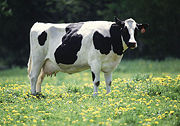
A highly mechanised agricultural sector employs no more than 4% of the labour force but provides large surpluses for the food-processing industry and for exports. The Dutch rank third worldwide in value of agricultural exports, behind the United States and France, with exports earning $55 billion annually. A significant portion of Dutch agricultural exports are derived from fresh-cut plants, flowers, and bulbs, with the Netherlands exporting two-thirds of the world's total. The Netherlands also exports a quarter of all world tomatoes, and one-third of the world's exports of peppers and cucumbers. The Netherlands' location gives it prime access to markets in the UK and Germany, with the port of Rotterdam being the largest port in Europe. Other important parts of the economy are international trade (Dutch colonialism started with cooperative private enterprises such as the VOC), banking and transport. The Netherlands successfully addressed the issue of public finances and stagnating job growth long before its European partners.
Currency
As a founding member of the Euro, the Netherlands replaced (for accounting purposes) its former currency, the "Gulden" ( Guilder), on January 1, 1999, along with the other adopters of the single European currency. Actual Euro coins and banknotes followed on January 1, 2002. One Euro is equivalent to 2.20371 Dutch guilders.


